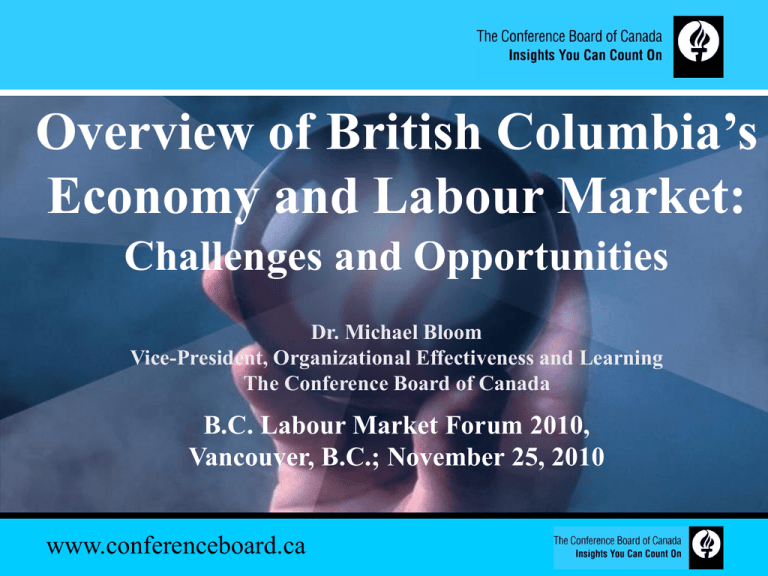Global And U.S. Context - The Province of British Columbia
advertisement

Overview of British Columbia’s Economy and Labour Market: Challenges and Opportunities Dr. Michael Bloom Vice-President, Organizational Effectiveness and Learning The Conference Board of Canada B.C. Labour Market Forum 2010, Vancouver, B.C.; November 25, 2010 www.conferenceboard.ca Global and U.S. Context • Weak recovery from recession is yielding modest GDP growth. • Developing economies are leading growth and creating new markets—and new competition. • U.S. recovery continues to be dampened by housing issues and relatively weak consumer confidence. www.conferenceboard.ca 2 World Real GDP Growth (annual per cent change) Source: Consensus Economics. www.conferenceboard.ca 3 Uneven Growth in Global Economy (per cent change, real GDP) 8.0 2009 2010 2011 6.0 4.0 2.0 0.0 -2.0 -4.0 -6.0 E.U. E. Europe North America Asia Pacific Latin America Source: Consensus Economics. www.conferenceboard.ca 4 U.S. Outlook • U.S. recovery is a year old—but pace of growth is slowing. • European debt crisis is prompting some firms to delay expansion. • Consumer and business investment spending on the mend but stronger job creation is needed. • Removal of fiscal and monetary stimulus needs to be done carefully. www.conferenceboard.ca 5 10.0 9.0 8.0 7.0 6.0 5.0 4.0 3.0 2.0 1.0 0.0 U.S. Unemployment Rate (per cent) '05 '06 '07 '08 '09 '10 '11 12 13 Sources: The Conference Board of Canada; Statistics Canada. www.conferenceboard.ca 6 Canadian Outlook • Canada’s recovery is built on the strength of the domestic economy—it needs a revival in U.S. employment to maintain momentum in 2011. • Core inflation, higher energy prices, rising sales taxes: have prompted the Bank of Canada to start lifting rates. www.conferenceboard.ca 7 Canadian Outlook • Higher rates and a fading European debt crises will keep the Loonie strong. • Real GDP growth of 3.0 per cent in 2010—easing to 2.5 per cent in 2011, as government spending cools. • Provinces will struggle with fiscal situation—for most, balancing budgets within five years will be difficult or impossible. www.conferenceboard.ca 8 Employment Growth Canada, 2001–12 2.5 2.0 1.5 1.0 0.5 0.0 -0.5 -1.0 -1.5 -2.0 272,000 job losses 01 02 03 04 05 06 07 08 09 10 11 12 Sources: The Conference Board of Canada; Statistics Canada. www.conferenceboard.ca 9 Canada Unemployment Rate vs. Natural Rate (per cent), 1981-2015 13.0 12.0 11.0 Unemployment Rate 10.0 9.0 8.0 7.0 6.0 Natural rate 5.0 Sources: The Conference Board of Canada; Statistics Canada. www.conferenceboard.ca 10 Can. Employment (000s) 2001-2015 2,400 2,300 2,200 Professional & Other Services 2,100 2,000 1,900 1,800 1,700 1,600 Manufacturing Sources: The Conference Board of Canada; Statistics Canada. www.conferenceboard.ca 11 Can. Housing Starts vs. Household Formation, 1997-2012 (000s) Household formation 240 220 200 180 160 140 120 Sources: The Conference Board of Canada; Canada Mortgage and Housing Corporation. www.conferenceboard.ca 12 B.C.’s Transformation • A past dependence on primary industries created a powerful image of B.C. that still survives in some quarters. • But the largest provincial industries are no longer forestry, mining, fishing and agriculture. • Reality: B.C.’s economy is transformed: services, construction and manufacturing are now dominant. www.conferenceboard.ca 13 British Columbia, 2011-12 CBoC Outlook Highlights • A post-Olympic slump will hurt the service sector in 2011, as several industries find themselves missing the one-time boost provided by B.C.’s hosting of the 2010 Winter Olympics. • Real GDP growth will moderate in B.C. in 2011 as public infrastructure stimulus spending comes to an end. www.conferenceboard.ca 14 B.C. Outlook – Autumn 2010 • The recovery will continue in the forestry, manufacturing and mining sectors, and new production from shale gas will support near-term GDP growth. • Forestry exports to China up 50 per cent; double-digit increases Japan; solid wood exports double to E.U. in 2010. • Mining is shining—metal mining output to double by 2013. www.conferenceboard.ca 15 B.C. Outlook – Autumn 2010 • Housing up in 2009, lost steam in 2010. • Housing starts will slow in 2011 (CBoC forecast). • Employment has recovered to prerecession levels but more part-time recovery than full-time. • Unemployment will fall to 6.8 per cent by 2013 (B.C. forecast). www.conferenceboard.ca 16 B.C. Real GDP Growth (percentage change, 2002 $) 6 5 4 3 2 1 0 03 04 05 06 07 08 09 10f 11f 12f 13f -1 -2 -3 Source: B.C. Ministry of Finance. www.conferenceboard.ca 17 Real GDP by Province, 2010 (percentage change; 2002 $) Sources: The Conference Board of Canada; Statistics Canada. www.conferenceboard.ca 18 Real GDP by Province, 2011 (percentage change; 2002 $) Sources: The Conference Board of Canada; Statistics Canada. www.conferenceboard.ca 19 Long-term GDP Growth Rankings (annual average growth, 2009-30) Sources: The Conference Board of Canada; Statistics Canada. www.conferenceboard.ca 20 B.C. Real GDP Growth (average annual growth) 3.5 3.0 2.5 2.0 1.5 1.0 0.5 0.0 2001-2005 2006-2010 2011-2015 2016-2020 2021-2025 2026-2030 Sources: The Conference Board of Canada; Statistics Canada www.conferenceboard.ca 21 Total Employment Growth by Province (percentage, 2005-30) 60 50 40 30 20 10 0 -10 -20 Sources: The Conference Board of Canada, Statistics Canada. www.conferenceboard.ca 22 B.C. Natural Resources vs. Other Goods (% of employment) 6.0 5.5 5.0 Other Goods, right axis 4.0 17.0 3.5 2.5 2.0 18.0 17.5 4.5 3.0 18.5 Natural Resources, left axis 16.5 16.0 15.5 Sources: Statistics Canada; B.C Stats. www.conferenceboard.ca 23 B.C. Construction and Manufacturing Employment (000’s) 250 Construction 200 150 100 Manufacturing 50 0 Sources: Statistics Canada; B.C Stats. www.conferenceboard.ca 24 B.C. Goods Sector (Goods sector as a % of total economy) 27 26 GDP 25 24 23 22 21 Employment 20 19 18 Sources: Statistics Canada; B.C Stats. www.conferenceboard.ca 25 B.C. Service Sector – Boosts GDP (GDP Index 1990 = 100) 200 180 Services 160 All industries 140 120 100 80 Goods 60 Sources: Statistics Canada; B.C Stats. www.conferenceboard.ca 26 B.C. Long-Term Outlook 2010-30 Highlights • Aging population will drive changes in the economy. • Supply constraints on labour are not far down the road. • Net international immigration will need to expand steadily over the forecast. • Potential output weakens through 2030. • Productivity gains would help sustain GDP. Source: The Conference Board of Canada. www.conferenceboard.ca 27 B.C. Potential Output Growth (contribution to growth, percentage points) Sources: The Conference Board of Canada; Statistics Canada. www.conferenceboard.ca 28 Average Weekly Wages (level $) $2,500 $2,000 Canada $1,500 $1,000 British Columbia Ontario Alberta $500 $0 Sources: The Conference Board of Canada, Statistics Canada. www.conferenceboard.ca 29 Real Output, Key Industries (ave. annual compound growth, per cent) Sources: The Conference Board of Canada, Statistics Canada. www.conferenceboard.ca 30 B.C.’s People • Today, 4.5 million people live in B.C.— 13 per cent of the national population. • B.C. produces 12.5 per cent of GDP. • Vancouver is third largest metropolitan area in Canada (after Toronto & Montreal). • Female population has grown faster than males since 1980—women outnumber men in urban regions—but not in rural areas. www.conferenceboard.ca 31 B.C.’s People • Population is aging – 36 per cent of individuals are under 30 years of age, while 27 per cent are over 55 years. • Immigration, especially from Asia, has been a major source of population growth. • As a result, B.C. is becoming more culturally and ethnically diverse. www.conferenceboard.ca 32 B.C.’s Aging Population www.conferenceboard.ca 33 B.C. Workforce in Goods Sector, 2009 0.0 1.0 2.0 3.0 4.0 5.0 6.0 7.0 8.0 9.0 10.0 Construction Manufacturing Agriculture Mining, oil & gas Forestry Utilities Fishing Sources: Statistics Canada; B.C. Stats. www.conferenceboard.ca 34 B.C. Workforce in Service Sector, 2009 0.0 2.0 4.0 6.0 8.0 10.0 12.0 14.0 16.0 18.0 Wholesale & Retail Trade Health care Accommodation & food Professional, scientific & technical services Education fFnance, insurance, real estate & leasing Transportation & warehousing Information, culture & recreation Public administration Business, building & support services Other services Sources: Statistics Canada; B.C Stats. www.conferenceboard.ca 35 B.C. Fastest Growing Industries (change in employment, 1990-2009) 0.0 50.0 100.0 150.0 200.0 250.0 300.0 350.0 Building services Other schools & educational support Warehousing & storage Security services Management of enterprises Management, scientific & technical services Waste management & remediation Motion picture & sound recording Computer system design Business services Sources: Statistics Canada; B.C. Stats. www.conferenceboard.ca 36 B.C. Fastest Growing Occupation Groups 2009-2019 • Health occupations (2.6 per cent annually) • Trades, Transport and Equipment Operators and Related Occupations (2.3 per cent annually) • Natural and Applied Sciences and Related Occupations (2.1 per cent annually) Source: B.C. Labour Market Outlook 2009-2019. www.conferenceboard.ca 37 B.C. Regions, 2009-2019 Employment Demand/Labour Growth Source: B.C. Labour Market Outlook 2009-2019. www.conferenceboard.ca 38 B.C. Labour Demand, 2009-19 Source: B.C. Labour Market Outlook 2009-2019. www.conferenceboard.ca 39 B.C. Projected Job Openings, 2009-19 Source: B.C. Labour Market Outlook 2009-2019. www.conferenceboard.ca 40 B.C. Change in Labour Supply and Demand (2009-19) 45,000 40,000 38,210 Demand 35,000 30,610 Supply 29,640 Supply 30,000 25,000 36,660 Demand 22,400 23,430 Supply 21,640 16,690 15,370 20,000 33,810 Demand 19,380 9,640 New Entrants (Supply) Replacement Demand 15,000 10,000 Net in-migration (Supply) Expansion Demand 15,810 5,000 15,020 14,270 13,920 14,430 13,790 0 O666 Cleaners O741 Motor vehicle and transit drivers O141 Clerical occupations, general office skills Occupations with greatest numbers of job openings are: Cleaners; Motor Vehicle and Transit Drivers and Clerical Occupations. Source: B.C. Labour Market Scenario Model 2009-2019. www.conferenceboard.ca 41 B.C. Top Demand Growth Trades-related Occupations 23,660 25,000 Demand 16,420 16,770 Supply Demand 20,000 13,790 9,850 10,290 Demand 11,550 Supply Supply 15,000 Net in-migration (Supply) 7,920 10,000 8,120 New Entrants (Supply) 1,520 Replacement Demand 7,600 6,650 Expansion Demand 13,370 5,000 8,500 0 O727 Carpenters and cabinetmakers 8,650 8,330 6,190 4,900 O624 Chefs and cooks O724 Electrical trades and telecommunication occupations Highest demand growth: Carpenters and Cabinetmakers; Chefs and Cooks; Electrical Trades and Telecom Source: B.C. Labour Market Scenario Model 2009-2019. Occupations. www.conferenceboard.ca 42 B.C. Change in Labour Supply and Demand (2009-19) 20,000 18,000 16,000 14,000 17,670 Demand 15,360 Supply 6,780 6,270 12,000 4,000 2,000 0 10,890 Replacement Demand Expansion Demand 7,460 8,000 New Entrants (Supply) 12,500 Supply 9,080 10,000 6,000 Net in-migration (Supply) 15,280 Demand 8,360 Demand 7,000 Supply 3,450 4,250 9,010 6,280 5,040 4,910 2,750 O761 Trades helpers and labourers O729 Other construction trades O761 Trades helpers and labourers Additional supply for “top growth” occupations will not meet the increase in demand over the next ten years. Source: B.C. Labour Market Scenario Model 2009-2019. www.conferenceboard.ca 43 B.C. Labour Market Outlook Key Challenges • B.C. will need to increase the size of its workforce, and ensure it has the right skills to support economic development. • Ambitious gains in participation rates and attracting more skilled immigrants are vital—but more is needed to meet demand. • Improving human capital to raise productivity is imperative. www.conferenceboard.ca 44 Employer Succession Challenge • Retirement of baby boomers will create business owner shortages that threaten the very existence of SMEs—so integral to the survival of rural B.C. • Today, 7 of 10 small business are owned by baby boomers; more than half are age 55+ and hope to retire within 5 years. • Next 3 decades will see a staggering number of small businesses go up for sale. www.conferenceboard.ca 45 B.C. Labour Market Outlook Key Challenges - Demand • 2.4 million people in B.C.’s labour force. • 1,126,000 job openings are expected for the province from 2009 to 2019 – equal to 47 per cent of the current labour force. • Approx. 60 per cent of job openings will be due to replacement demand, 40 per cent will be due to expansion. www.conferenceboard.ca 46 • Replacement: 676,000 additional jobs will be vacant due to retirements and deaths. • Expansion: employment is expected to grow by 1.8 per cent annually to 2019 – creating 450,000 new jobs. Source: B.C. Labour Market Outlook 2009-2019. www.conferenceboard.ca 47 B.C. Labour Market Outlook Key Challenges - Supply • Only 650,000 young people in K-12 system today – growth in job openings will outpace the number of workers required to support economic growth. • Number of new entrants is expected to decline over the outlook, averaging a drop of 0.4 per cent annually. www.conferenceboard.ca 48 B.C. Labour Force Growth (average annual growth) 2.5 2.0 1.5 1.0 0.5 0.0 2001-2005 2006-2010 2011-2015 2016-2020 2021-2025 2026-2030 Sources: The Conference Board of Canada; Statistics Canada www.conferenceboard.ca 49 B.C. Employment/Labour Growth (ave. annual per cent change) Sources: The Conference Board of Canada; Statistics Canada. www.conferenceboard.ca 50 B.C. Labour Force Participation Rate (1976-2030, per cent) Sources: The Conference Board of Canada, Statistics Canada. www.conferenceboard.ca 51 B.C. Immigration Drives L.F. Growth Source: B.C. Stats 2009. www.conferenceboard.ca 52 B.C. Labour Productivity (per cent change, compound annual growth) 1.6 1.4 1.2 1.0 0.8 0.6 0.4 0.2 0.0 2001- 2006- 2011- 2016- 2021- 20262005 2010 2015 2020 2025 2030 Sources: The Conference Board of Canada; Statistics Canada. www.conferenceboard.ca 53 B.C. Education Requirements • Over the next decade, 77 per cent of all jobs will require some post-secondary education. Source: B.C. Labour Market Outlook 2009-2019. www.conferenceboard.ca 54 Human Capital • Improving human capital is essential to productivity, competitiveness, and performance of our organizations and communities. • Human Capital is one of three key drivers of productivity and organizational performance. • Others are financial capital and physical capital – machinery and equipment. Source: The Conference Board of Canada. www.conferenceboard.ca 55 Human Capital and Productivity • Canada’s productivity performance is falling relative to other nations, partly due to our labour and skills shortages. • Skills shortages often (not always) result from labour shortages in workplaces. • Skills shortages also due to gaps, mismatches and obsolescence, as sectors and nature of work changes. www.conferenceboard.ca 56 Productivity Drivers Human capital Firm-Specific Factors Business & Policy Environment Global Forces Trade liberalization World commodity price changes www.conferenceboard.ca Political events Other global events Source: The Conference Board of Canada 57 Innovation • Innovation is a key to productivity gains—so hire for it, develop people for it, and reward it—create a corporate culture to promote it. • New products and services can add value to increase revenues and profit per hour worked by employees. • Process, incremental innovations that improve customer experience also improve productivity and the bottom line. www.conferenceboard.ca 58 Improve Productivity for Growth www.conferenceboard.ca 59 The Contribution of Learning and Skills to Business Performance Sources: Institute for Employment Studies, University of Sussex. www.conferenceboard.ca 60 B.C. Labour Market System www.conferenceboard.ca 61 Elements of B.C. Labour Market System 1. Accessible and reliable labour market information to help guide investments and decision-making. 2. Policy and regulations that provide a quality working environment to support workers. www.conferenceboard.ca 62 Elements of B.C. Labour Market System 3. Coordinated network of organizations that support connections between workers and employers, and workers with training; and 4. Responsive education/training system that meets provincial & regional economic needs. www.conferenceboard.ca 63 Meta-Strategies for Addressing Labour Shortages 1. Increase expertise, skills of workforce by providing more post-secondary education and training to the already employed. 2. Increase supply of workers by attracting international and interprovincial migrants. 3. Increase supply of workers by making more effective use of under-represented populations. www.conferenceboard.ca 64 Expand the Skilled Talent Pool: Focus on Under-represented Populations 1. Older workers – 65 years+ 2. Immigrants 3. Women – 15-64 years 4. Disengaged youth – 16-25 years 5. Aboriginal Peoples 6. People with disabilities www.conferenceboard.ca 65 Harnessing Valuable Talent: 1. Older Workers • Employing strategies that target older workers, will help close skills gap, e.g.: – Reduce incentives for early retirement; – Encourage later and flexible retirement; – Legislation to counter age discrimination; – Help older workers find/keep jobs and ‘re-skill’for late-career transitions. www.conferenceboard.ca 66 Harnessing Valuable Talent: 2. Immigrants • Immigrants and internationally educated talent boost economy: – Generate innovation and creativity; – Add skilled workers to labour force; – Enrich our global economic perspective; and – Provide connections to foreign markets. www.conferenceboard.ca 67 Immigrants are Good for Business • Immigrants are an important source of population and labour market growth. • Overall, net migration to B.C. is expected to remain in 50-60,000 range through to 2019. • Immigration should be sustained and increased with careful targeting of skills; provincial nominee programs and special programs for grad students can help. www.conferenceboard.ca 68 Harnessing Valuable Talent: 3. Women • Women: 50.5 per cent of B.C. population. • The labour force participation rate gap with men is 10 per cent. • Women earn less: Can. women working full time, full year in 2008: $44,700 versus $62,600 for men—gap of 28.7 per cent. • Women under-represented in science and tech at university and in related careers. www.conferenceboard.ca 69 Harnessing Valuable Talent: 4. Disengaged Youth • Cutting HS drop-out rate and increasing post-secondary completion can help. • High impact from targeting “youth-atrisk”: drop outs, in alternate education programs, Aboriginal, disabilities, or combinations of these. • Retaining to HS graduation will increase flow into more advanced workforce prep. www.conferenceboard.ca 70 Harnessing Valuable Talent: 5. Aboriginals • 2006: 196,000 Aboriginals in B.C., 4.8 per cent of prov. population; one-quarter of population (55,250) is <15. • Aboriginal pop. lags non-Aboriginal pop. in education: 2007: 35 per cent of Aboriginals, 15-24 (not still studying), had not completed a HS or PSE credential–– vs. 21 per cent of non-Aboriginal youth. www.conferenceboard.ca 71 High Aboriginal Unemployment Rates • Aboriginal unemployment rate of 16.1 per cent in 2009, more than twice unemployment rate for non-Aboriginals. • Participation rate in labour force is about 12 per cent lower for Aborig. men and 13 per cent lower for Aborig. women compared to non-Aboriginals. • Providing skills training and labour market integration support is key. www.conferenceboard.ca 72 Harnessing Valuable Talent: 6. Persons with Disabilities • 355,430 working-age persons with disabilities in B.C. – many want to work and have excellent skills and talents. • Their employment rate is only 59 per cent. • Number of disabled workers will increase as aging workers experience disabling health problems—many should be retained or brought into workforce. Sources: B.C. Stats, 2006 PALS survey. www.conferenceboard.ca 73 Implementing a Strategy for Growth • B.C. recognizes the need to solve the labour force skills gap that threatens the province’s future economic growth. • It has identified the major elements of a labour force strategy—to attract immigrants and nurture the skills of B.C.’s people—that will build the capacity B.C. requires to sustain economic growth. • There is no single solution! www.conferenceboard.ca 74 Implementing a Strategy for Growth • Implementing a sustained skills strategy for growth should be seen as an investment— not a ‘cost’. • This investment takes time to bear fruit—it is crucial to implement ASAP. • Business, educators, communities, indivs. all have major roles to play in partnership with gov’t.—ongoing collaboration on labour market solutions is the best way to make possible the future everyone wants! www.conferenceboard.ca 75 Three Key Labour Market Priorities for B.C. • Increase participation of under-represented and under-utilized people within B.C. – and get all British Columbians skills they need to be successful in the labour market. • Attract top talent from around the world where gaps in workers and skills arise. • Improve innovation to enhance productivity by continuing to support human capital development. www.conferenceboard.ca 76











